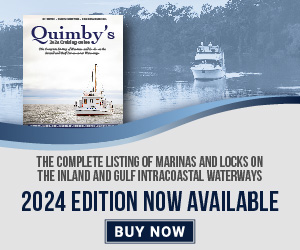AAPA Sees Chance For ‘Historic’ Harbor Tax Measure
This January, the 84 U.S.-member ports of the American Association of Port Authorities (AAPA) hammered out an agreement among themselves on how harbor tax money should be spent. The “historic” agreement focused the voice of the AAPA more strongly than ever in Washington, D.C., public affairs director Aaron Ellis told The Waterways Journal.
“Ever since the U.S. Harbor Maintenance Tax (HMT) was enacted by Congress [in the Water Resources Development Act of 1986], our member ports have had differences among themselves about how the money should be spent. Those that needed little or no dredging believed they deserved more benefit from the harbor maintenance taxes collected at their ports. This raised calls for ‘donor equity’ among ports whose HMT collections were much larger than their dredging needs.”
Meanwhile, Congress hasn’t appropriated the full amount of annual HMT collections, causing a good deal of deferred maintenance needs in America’s deep-draft shipping channels. Money from the Harbor Maintenance Trust Fund (HMTF) has historically been doled out stingily, partly to help the appearance of the federal government balancing its books. The unspent money piled up and now amounts to more than $9 billion.
“This broken system is what our agreement tries to fix,” said Ellis. “We’re simply asking our elected officials that the receipts from this already existing tax be spent for their intended purpose, in a way that treats everyone fairly. We’ve seen decades of partial appropriations, resulting in delays and increased transportation costs, which helps to make imported goods more expensive and American-made goods less competitive overseas.”
Same Songbook
“Now that U.S. ports are effectively singing from the same songbook, it makes our collective voice more powerful,” Ellis added. “It really helps when every member of Congress from a maritime state, or who represents a port district or serves on a transportation committee, is hearing the same thing about the need to spend the Harbor Maintenance Tax properly and is not hearing divisions among ports.”
The agreement, he said, would continue to keep traditional maintenance needs as the highest priority while returning some HMT funding to donor and energy transfer ports.
This unified voice is needed more than ever, said Ellis, as Congress puts together the next Water Resources Development Act (WRDA). Every $1 billion in exports translates into about 15,000 American jobs. There is a real chance, said Ellis, that this bill could include the “permanent solution” to full HMT appropriations that members are looking for.
Three-Step Plan
Under the AAPA’s preferred plan, which it calls the Long-Term Funding Solution for Port Maintenance, HMT revenues up to $1.58 billion would automatically be transferred to the Corps of Engineers, complementing the $155 billion in capital investments that ports and their private-sector partners said they planned to spend between 2016 and 2020.
Spending would proceed in a three-step process. In the initial step, 90 percent of the HMT revenues would be devoted to channel maintenance and 10 percent to donor and energy transfer ports. In the intermediate state, the percentages would shift to 85 and 15 percent, and in the “fully maintained stage,” to 80 and 20 percent. What AAPA calls “emerging harbors” (i.e., those that handle less than 1 million tons of cargo annually) would receive no less than 10 percent of the HMT revenues, as required by current law. Corresponding to the Corps of Engineers districts, each of the six port regions (Northeast, Southeast, Gulf, Great Lakes, Northwest and Southwest) would receive at least 10 percent.
Preserving TIGER Grants
Among AAPA’s goals is making sure to preserve the multimodal Transportation Investment Generating Economic Recovery (TIGER) grant program in the FY 2019 appropriations bill for Transportation, Housing and Urban Development. On March 29, the AAPA sent a letter to members of the House and Senate Committees on Appropriations supporting the same funding level of $1.5 billion in multimodal funding that was included in the FY 2018 Omnibus bill and urging that a minimum of 25 percent of the funding be dedicated to port-related needs.
The AAPA also urges that port projects not be counted towards a state’s 10 percent cap for this funding, since “port projects typically connect metropolitan with rural economies and tend to have economic impacts beyond other local and regional projects,” Ellis said.
The TIGER program is a top priority for AAPA, since it is one of the few multimodal grant programs. Other U.S. Department of Transportation grant programs like FASTLANE “are primarily highway focused, outside the gate project, whereas TIGER has funded important inside the gate projects that assist ports to be ‘big ship ready’ for the 21st century and assist in returning existing facilities to a good state of repair,” he said.
According to AAPA, the TIGER program has funded 49 port-related projects worth a total of about $624 million to date.
In a recently released report titled “State of Freight III – Rail Access and Multimodal Funding Needs,” AAPA port members identify more than $20 billion in projected multimodal port and rail access needs over the next decade.


